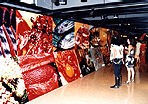Kishin Shinoyama Photo Exhibition "SHOKU"
- July 19 - August 31, 1996
- Kirin Art Space Harajuku
- Tel. 03-5485-6321

Kishin Shinoyama Photo Exhibition "SHOKU"
|

Kishin Shinoyama Photo Exhibition "SHOKU"
 Noi SAWARAGI Noi SAWARAGI
The closed space where "food" jostles
There are not many exhibitions that take your breath away the moment you
step in. Even if there were, so rare are such exhibitions that can sustain
the first impact. However, in this exhibition, the first shock that runs
through a person does not cease until he leaves the gallery. The first
surprise is not a mere introduction to lead you onto see the other
photographs, but it is closely connected withh the nature of photography.
The success of this exhibition, that displays a full array of photographs
under the theme, "SHOKU (Food)", can also be attributed to the idea of
taking advantage of the display space. The closed space of "SHOKU"
covering all the walls of the horizontally long Kirin Art Space, comprises
of a polished floor, a relatively low ceiling, various reflections due to
the lighting, and glossy panels of the photos displayed in the shape of a
"stomach". Therefore, visitors who come to appreciate the food find
themselves "swallowed" by the food and visited by a fear of being
"digested". This is a place where food, that has been obediently falling
prey to the predator, in turn becomes the predator consuming its prey.
Hence, those who visit thinking they would be the "observer" become the
food under observation.
The gentleness and elegance of "Washoku (Japanese cuisine)" which
instigates fear
It is also interesting how Shinoyama limited his shooting of various food
to Japanese food.
Japanese food may have been perceived with a softer and classier image,
relative to Chinese and French cuisine, in both visual and taste aspects.
However, as far as Kishin Shinoyama's photos demonstrate, one realizes that
that is only an illusion. Washoku is best characterized as food with the
least labor and time spent on the original ingredients. Thus, if this is
referring to the tenderness and classiness of Washoku, that tenderness and
classiness require only minimum labor to devour the "life" of the
ingredients in its entirety.
The cruelty of slurring dripping blood, devouring twitching meat, gulping
down the juice squeezed out from in-between the bone and the meat, could be
the essence of the gentle and elegant Japanese cuisine.
The exhibition's attempt to dig down deep into the Japanese sensibility of
"shoku (food)" invites a fearful thought that this "Wa (Japanese)" is
maintained by applying relentless violence onto another party called
"food".
[Noi SAWARAGI/Art Critic]
|

![]()
